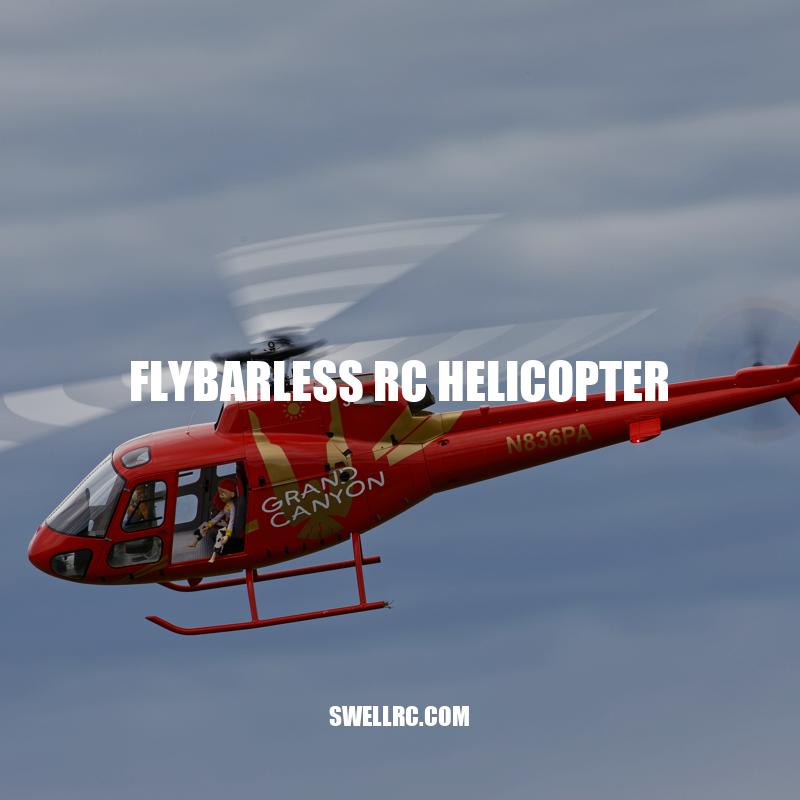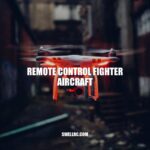Flybarless RC Helicopter: Benefits and Advantages
Flybarless RC helicopters have become a popular choice for remote control enthusiasts. With a modern and advanced electronic flybarless system, these helicopters offer a superior level of stability, increased agility, and better aerobatic capabilities compared to their traditional counterparts. The electronic system is designed to manage the helicopter’s balance without the need for an external flybar, which eliminates common problems and enhances the overall performance of the helicopter. Although this technology was introduced in 2008, it has continued to evolve, and several companies have developed their own flybarless systems, each offering unique features and benefits. The flybarless technology has several advantages over traditional flybar helicopters, including improved reliability, easier maintenance, and faster response times. As a result, these helicopters have quickly become a favorite among RC helicopter enthusiasts. However, due to their technical complexity, setting up and flying a flybarless RC helicopter requires some knowledge and expertise, making it a challenge for beginners. Nonetheless, with some practice, pilots can take advantage of the increased maneuverability and perform impressive stunts with these remarkable flying machines.
History of flybarless technology
Flybarless technology was first introduced in 2008 by MSH Electronics, a Swiss company. This company designed the first integrated flybarless electronic system for RC helicopters. The technology replaced the flybar system, which balanced the rotor blades and provided stability to traditional RC helicopters. The flybarless system uses a three-axis gyroscope sensor, which detects and corrects any deviations in the helicopter’s orientation, making it more maneuverable and less prone to oscillations, vibrations, and mechanical failures.
Since 2008, other companies have developed their flybarless systems. Here is a list of some of the manufacturers of flybarless systems:
- MSH Electronics – the company that introduced the flybarless system in 2008
- Align – the world’s largest manufacturer of RC helicopters offers two flybarless systems – the 3GX and the MRS
- Mikado – a German-based company that offers the VBar system
- BeastX – a relatively new company that offers the popular BeastX flybarless system
Table 1: A comparison of some flybarless systems
| Manufacturer | System Name | Price | Features |
|---|---|---|---|
| MSH Electronics | Brain 2 | $239.99 | 17ms latency, 3-axis MEMS gyroscope, and 3-axis MEMS accelerometer |
| Align | 3GX | $180.00 | Advanced parameters via Bluetooth, 3-axis MEMS gyroscope, and 3-axis MEMS accelerometer |
| Mikado | VBar | $284.40 | 3-axis MEMS gyroscope and 3-axis MEMS accelerometer, iOS and Android apps available |
| BeastX | BeastX Plus | $249.95 | 3-axis MEMS gyro, easy setup assistant, and bailout function |
What is a flybarless RC helicopter?
A flybarless RC helicopter is a type of remote-controlled helicopter that doesn’t have a flybar. Instead, electronic stabilization systems replace the flybar, making them “virtual” or “electronic flybars”. This type of helicopter allows for more precise and responsive movements, making them popular among experienced RC pilots. For more information, you can visit websites like Horizon Hobby or RC Planet that offer a range of flybarless RC helicopters for sale.
Flybarless technology has several advantages over traditional flybar helicopters. Some of these advantages include:
- Reduced mechanical complexity of the helicopter, leading to easier maintenance and increased reliability
- Improved performance, especially in 3D maneuvers, due to its fast response and superior stabilization
- More precise control of the helicopter allows pilots to perform more complex tricks and stunts
- Improved fuel efficiency, as the flybarless system uses less power to control the helicopter
In recent years, flybarless technology has become increasingly popular, and it’s now widely available in many hobby shops, RC helicopter forums, and online stores. One of the most popular flybarless systems is the ALIGN 3GX, which is easy to set up, offers excellent performance, and is compatible with a wide range of RC helicopters.
Table 1: A comparison of traditional flybar and flybarless helicopters
| Feature | Traditional Flybar Helicopter | Flybarless Helicopter |
|---|---|---|
| Mechanical Complexity | High – includes flybar and associated linkages | Low – no flybar or associated linkages |
| Rotor Head | Simpler design | Higher blade count and advanced rotor head design |
| Stress on components | More stress on flybar and linkages, which can lead to mechanical failures | Less stress on components |
| Stability and Control | Less stable and harder to control | More stable and easier to control |
| Cost | Lower cost | Higher cost due to advanced technology and better performance |
What is the difference between flybar and flybarless in helicopter?
In a nutshell, a flybar is a mechanical solution for stability in model helicopters while flybarless is an electronic solution. Flybarless offers more adjustability and precision compared to flybars. Although flybars work well, they have issues with interaction, extra drag, and mechanical complexity. For more information on helicopter parts and accessories, you can check websites like horizonhobby.com or rcplanet.com.
A flybarless RC helicopter has several key components that work together to create a smooth and stable flying experience. Some of these components include:
- Main rotor blades – usually made of carbon fiber or another lightweight material, these blades are essential for lifting the helicopter off the ground and keeping it in the air
- Electronic flybarless system – this is the brain of the helicopter, which manages the orientation, stability, and balance of the helicopter
- Brushless motor – provides power to the rotor blades and controls the speed during flight
- Battery – provides power to the motor and the electronic flybarless system
- Receiver – receives control signals from the transmitter and sends them to the flybarless controller
- Flybarless controller – a small computer that interprets the input signals from the receiver and provides the necessary corrections to maintain stability and balance
- Three-axis gyroscope sensors – detects deviations in the helicopter’s orientation and sends correction signals to the brushless motor to adjust the rotor blades accordingly
One of the most important factors in building a flybarless RC helicopter is choosing the right components. There are many brands and models of each component available on the market, and it’s essential to ensure that they are all compatible and work well together. Some popular brands of flybarless systems include:
It’s worth doing some research and checking online forums to get advice from experienced pilots before making a purchase. Table 2 provides an overview of the most important factors to consider when choosing components for a flybarless RC helicopter.
Table 2: Factors to consider when choosing components for a flybarless RC helicopter
| Component | Important factors to consider |
|---|---|
| Main rotor blades | Length, weight, material, compatibility with flybarless system |
| Electronic flybarless system | Compatibility with receiver and flybarless controller, ease of use, features such as programmable settings, vibration resistance |
| Brushless motor | Power output, compatibility with battery, durability, brand reputation |
| Battery | Voltage and capacity, weight, compatibility with motor and electronic flybarless system, safety features such as overcharge protection |
| Receiver | Compatibility with transmitter and flybarless controller, range, number of channels, brand reputation |
| Flybarless controller | Compatibility with electronic flybarless system, ease of use, features such as sensitivity and programmable settings, brand reputation |
What is the difference between flybar and flybarless RC helicopters?
The main difference between flybar and flybarless RC helicopters is that flybars use a mechanical solution for stability while flybarless ones use an electronic solution. Flybars face challenges with extra drag, mechanical complexity, and interaction. On the other hand, flybarless helicopters generally have increased adjustability and precision. For more details, refer to the relevant websites or products.
Setting up a flybarless RC helicopter
Setting up a flybarless RC helicopter can be a bit more complicated than a traditional flybar helicopter, but it’s essential to ensure that the electronic flybarless system is correctly calibrated to prevent any erratic behavior during flight. Here are some important steps to follow when setting up a flybarless RC helicopter:
- Attach the main rotor blades to the rotor head and make sure they are securely fastened
- Install the electronic flybarless system according to the manufacturer’s instructions
- Calibrate the electronic flybarless system using the software provided or a programming card
- Check the pitch control, cyclic control, and tail control systems for proper alignment and movement
- Ensure that the receiver and transmitter are properly bound and that the control inputs are set up correctly on the transmitter
- Perform a hover test to make sure the helicopter is stable and balanced
- Tweak any settings as needed to achieve optimal performance
It’s worth noting that setting up a flybarless RC helicopter can be time-consuming, and it’s essential to be patient and take your time to avoid any mistakes. It’s also helpful to get advice from experienced pilots or consult online forums for tips and tricks.
One useful tool to have when setting up a flybarless RC helicopter is a pitch gauge, which measures the blade pitch angle and helps ensure that the blades are perfectly aligned. Some other tools that can come in handy include a screwdriver set, a hex key set, and a digital multimeter.
Table 3 provides an overview of some essential tools and accessories for setting up a flybarless RC helicopter.
| Tool/accessory | Purpose |
|---|---|
| Pitch gauge | Measures blade pitch angle and helps ensure proper alignment |
| Screwdriver set | Used for tightening screws and bolts |
| Hex key set | Used for tightening hex screws and bolts |
| Digital multimeter | Used for testing voltage, resistance, and continuity |
| Programming card | Used for programming electronic flybarless systems without a computer |
| Training gear | Helps prevent damage to the helicopter during crashes and aids in learning to hover |
What is the purpose of flybar on RC helicopter?
Flybars are an essential component of RC helicopters as they add stabilization to the rotor disc. This is done through automatic changes in cyclic pitch angles of the rotor blades, which greatly improves cyclic stability and makes cyclic control much more manageable. If you want to learn more about flybars and head types, check out the relevant page on the website.
Flying a Flybarless RC Helicopter
Flying a flybarless RC helicopter can be a thrilling experience, but it can also be challenging, especially for beginner pilots. Here are some tips to help you get started flying a flybarless RC helicopter:
- Start with basic maneuvers like takeoff, hover, and landing
- Practice orientation skills by flying the helicopter towards and away from yourself
- Gradually increase speed and altitude as you become more comfortable
- Avoid flying in crowded areas or near people and animals
- Stay focused and alert while flying and avoid distractions
- Be prepared for crashes or malfunctions and always have spare parts and tools on hand
- Learn from experienced pilots or consult online forums for tips and advice
It’s also worth noting that a flybarless RC helicopter can be much more agile and responsive than a traditional flybar helicopter. This can be exciting for experienced pilots looking to perform advanced maneuvers, but it can also be intimidating for beginners. It’s important to take your time and not rush into complex maneuvers until you have built up your skills and confidence.
One key accessory that can be helpful for beginners learning to fly a flybarless RC helicopter is training gear, which is essentially a set of skids that attach to the helicopter and provide extra stability and protection during crashes. Training gear can be particularly useful when practicing hovering, which can be one of the more challenging aspects of flying a flybarless RC helicopter.
Table 4 provides an overview of some recommended training gear for a flybarless RC helicopter.
| Product | Purpose |
|---|---|
| Blade MCPX Training Gear | Helps prevent damage during crashes and aids in learning to hover |
| Align T-Rex 150 Training Gear | Provides extra stability during takeoff and landing |
| Walkera QR Ladybird Training Gear | Helps prevent damage during crashes and aids in learning to hover |
| SYMA S107G Training Gear | Designed for beginner pilots learning to fly a helicopter |
| Hubsan X4 Training Gear | Designed for beginner pilots learning to fly a quadcopter |
How hard is it to fly an RC helicopter?
Learning to fly an RC helicopter can be mentally exhausting, especially when it comes to hovering a collective pitch RC helicopter. Most people can handle an hour or two of flying, spread out over an afternoon, before they start making mistakes. However, with patience, practice, and dedication, anyone can master the skill of flying an RC helicopter. There are many resources available online, such as RC forums and YouTube channels, that offer tips, tricks, and tutorials on how to fly RC helicopters. Additionally, there are specific products available, such as flight simulators, that can help beginners sharpen their skills before taking to the air with a physical helicopter.
Conclusion
In conclusion, a flybarless RC helicopter is an exciting and advanced technology that has changed the RC helicopter industry for the better. With its increased stability, superior performance, and easier maintenance, it’s no wonder that flybarless technology has become so popular among RC helicopter enthusiasts. However, flying a flybarless RC helicopter can also be challenging, especially for beginners, so it’s important to take your time and practice the basics before attempting more advanced maneuvers.
Overall, a flybarless RC helicopter is a fantastic choice for anyone who wants to challenge themselves and experience the thrill of flying a sophisticated model aircraft. Whether you’re an experienced pilot or a complete beginner, there are plenty of resources available online to help you get started with this exciting hobby. From online tutorials and forums to specialized training gear and high-quality equipment, anyone can learn to fly a flybarless RC helicopter with dedication and practice. So why not take the plunge and try out this amazing technology for yourself? Once you experience the thrill of flying a flybarless RC helicopter, you may never want to go back to traditional flybar models again!



